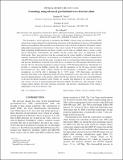Cosmology using advanced gravitational-wave detectors alone
Author(s)
Mandel, Ilya; Taylor, Stephen R.; Gair, Jonathan R.
DownloadTaylor-2012-Cosmology using advanced gravitational-wave detectors alone.pdf (596.0Kb)
PUBLISHER_POLICY
Publisher Policy
Article is made available in accordance with the publisher's policy and may be subject to US copyright law. Please refer to the publisher's site for terms of use.
Terms of use
Metadata
Show full item recordAbstract
We investigate a novel approach to measuring the Hubble constant using gravitational-wave (GW) signals from compact binaries by exploiting the narrowness of the distribution of masses of the underlying neutron-star population. Gravitational-wave observations with a network of detectors will permit a direct, independent measurement of the distance to the source systems. If the redshift of the source is known, these inspiraling double-neutron-star binary systems can be used as standard sirens to extract cosmological information. Unfortunately, the redshift and the system chirp mass are degenerate in GW observations. Thus, most previous work has assumed that the source redshift is obtained from electromagnetic counterparts. However, we investigate a novel method of using these systems as standard sirens with GW observations alone. In this paper, we explore what we can learn about the background cosmology and the mass distribution of neutron stars from the set of neutron-star (NS) mergers detected by such a network. We use a Bayesian formalism to analyze catalogs of NS-NS inspiral detections. We find that it is possible to constrain the Hubble constant, H[subscript 0], and the parameters of the NS mass function using gravitational-wave data alone, without relying on electromagnetic counterparts. Under reasonable assumptions, we will be able to determine H[subscript 0] to ±10% using ∼100 observations, provided the Gaussian half-width of the underlying double NS mass distribution is less than 0.04 M[subscript ⊙]. The expected precision depends linearly on the intrinsic width of the NS mass function, but has only a weak dependence on H[subscript 0] near the default parameter values. Finally, we consider what happens if, for some fraction of our data catalog, we have an electromagnetically measured redshift. The detection, and cataloging, of these compact-object mergers will allow precision astronomy, and provide a determination of H[subscript 0] which is independent of the local distance scale.
Date issued
2012-01Department
MIT Kavli Institute for Astrophysics and Space ResearchJournal
Physical Review D
Publisher
American Physical Society
Citation
Taylor, Stephen, Jonathan Gair, and Ilya Mandel. “Cosmology Using Advanced Gravitational-wave Detectors Alone.” Physical Review D 85.2 (2012): n. pag. Web. 11 May 2012. © 2012 American Physical Society
Version: Final published version
ISSN
1550-7998
1089-4918